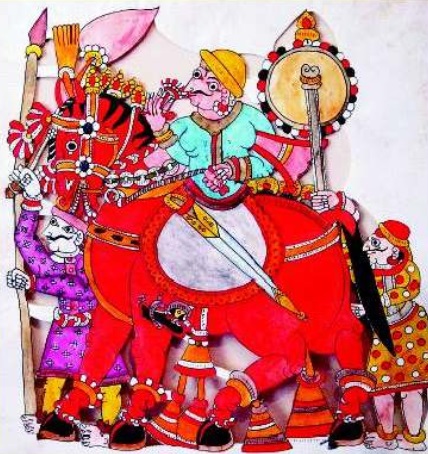Tribal art: India
This is a collection of articles archived for the excellence of their content. |
Tribal art work
Paris-based Herve Perdriolle gallery, specializing in tribal Indian art to participate in the India Art Fair in January, 2012. Two galleries dedicated to this genre have also come up in Delhi. The indigenous canvas has never looked brighter
Archana Khare Ghose
Coca Cola’s 2010 Diwali commercial will remain an unlikely landmark for Indian tribal art for a long time to come. It was the most stunning example of popular culture incorporating elements of tribal art, the long neglected ‘other’ art of the country. With the snazzy number Jaata Kahan Hai Deewaney as the backdrop, the commercial showed skeletal figures drawn on the soft drink bottle breaking off into a jig. These are the same signature figures the Warli tribesmen of Maharashtra paint on their mud-plastered walls and on paper.
That may have been a one-off tribute to Warli art, but the so far ignored tribal art of India is on the verge of finding its spot under the sun. Unmistakable tectonic shifts are taking place in its earthy precincts. Though it still has a long way to go to reach the ‘aha’ levels of urban contemporary art, it has at least found a foot in the door.
To begin with, a tribal art work by the late — and also the most celebrated — Gond artist Jangarh Singh Shyam was given the same platform as that accorded to the works of Husain or Raza at a Sotheby’s auction in London in March 2010. It was picked up for Rs 6.4 lakh, double its highest pre-auction estimate. Then, the past two years have seen the opening up of two private art galleries dedicated to tribal art — Meena Verma’s Arts of the Earth, and Tulika Kedia’s Must Art — both of which are located in Lado Sarai, Delhi. Now, the India Art Fair that will be held at Delhi in January next year will see participation by the Paris-based Galerie Herve Perdriolle, which is dedicated to Indian tribal art. That’s a first for the fouryear-old fair.
“Yes, Indian tribal art is on the brink of the recognition that it deserves,” says Jyotindra Jain, professor at JNU. He was the first to curate an exhibition of folk-tribal art, titled The Other Masters, at the Crafts Museum 13 years ago when he was the director there. The show had emphasised on individual identity within the collective tradition of the art forms. “With the entry of folk- tribal art in contemporary spaces, the notion of ‘signature’ has emerged, which has made galleries and auctions dedicated to it viable,” says Jain.
Largely identified by the name of the tribe or place where it is practised, tribal-folk art now boasts of signatures that come with price tags. While Jangarh Shyam remains the most famous Gond signature, Jivya Soma Mashe is his equivalent in the Warli world. The two of them may still be on the periphery of being art celebs in their own country but are routinely feted in art capitals of the West. They were both exhibited in the prestigious Magicians of the Earth exhibition curated by Jean Hubert Martin at Centre Pompidou, Paris, in 1989.
“I’ve always believed that when urban contemporary artists would have achieved a substantial price, then there would be space for rural contemporary artists, too. That’s what is about to happen in India,” says Herve Perdriolle, the French connoisseur who owns the eponymous Paris gallery. Perdriolle will showcase works by the late Chano Devi (Madhubani), Jangarh and his son Mayank Shyam (Gond), and Pushpa Kumari (Mithila) at the India Art Fair. While all this calls for applause, the threshold of success is a dangerous place to be in, caution those who plough the rather lonely furrow of tribal art. The first casualty was registered 10 years back when Jangarh committed suicide while on a residency in Japan. In the changing dynamics of tribal art, Jain warns against market pressure which could lead to mediocre mass production. Kedia also cautions against inflation of prices. “Even as we help Gond artists achieve good prices, we don’t want to create a bubble. It would burst and then genuine collectors too would lose interest,” she says.
Top Gond artists like Bhajju Shyam (Jangarh’s nephew) and Mayank Shyam command Rs 2 lakh to Rs 3 lakh for their canvases whereas Perdriolle had sold two of Jangarh’s paper works for Rs 7 lakh and Rs 8 lakh last year. Alongside, substantial collections of these art forms have also been built — Anupam Poddar of the Devi Art Foundation has one of the largest Gond art collections while Perdriolle’s Warli art pool is almost legendary.
A story on Indian tribal art can never be complete without flogging the old reprehensible horse — the government — which has fallen short of expectations. Jain points to a vital aspect of nurturing tribal art when he cites the example of Australian aboriginal artists who are far better placed, not only in terms of exposure and prices but also with respect to their Intellectual Property Rights. Australian aboriginal artist Clifford Possum holds the record for the highest price for folktribal art ever with the figure of Rs 11 crore, compared to which the record for an Indian tribal art work seems paltry — Rs 9.8 lakh for a Mashe work. But the prices right now are a magnet for collectors. Neha Kirpal, founding director of the India Art Fair, says that tribal art should entice the young collectors as “the market for this genre of art market is still nascent and a lot of good quality work will be available at reasonable prices.” It’s a long road ahead for tribal art to reach where its urban counterpart stands now. But it looks like the journey has begun.

